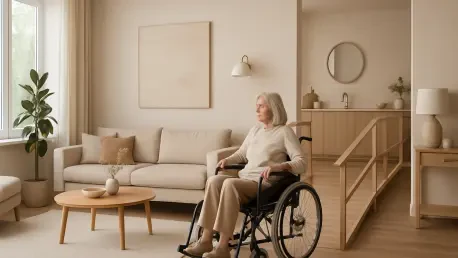Imagine a home where every element serves a purpose, not just in utility but also in enhancing visual appeal, even when it comes to accessibility solutions like home lifts. For too long, the notion of mobility aids has been tied to clunky, uninspired designs that clash with personal style, often hidden away to avoid disrupting a home’s aesthetic. Yet, a groundbreaking collaboration between a leading home lift specialist and an award-winning interior designer is challenging this outdated perception. This partnership is proving that accessibility equipment can be seamlessly integrated into home decor, offering both practicality for daily needs and elegance that complements individual tastes. By reimagining how these solutions fit into living spaces, the initiative is sparking a broader conversation about the intersection of design and functionality, paving the way for homes that adapt to changing needs without sacrificing beauty or personal expression.
Redefining Accessibility Through Design
Blending Aesthetics with Practical Solutions
The collaboration between a home lift innovator and a celebrated interior designer marks a pivotal shift in how accessibility tools are perceived within domestic environments. Far from being mere functional necessities, home lifts are being transformed into statement pieces that elevate interior spaces. This vision comes to life through bespoke designs, such as exclusive fabrics crafted to adorn these lifts, turning them into focal points rather than items to conceal. The emphasis is on creating equipment that aligns with a homeowner’s decor, ensuring that mobility aids enhance rather than detract from the ambiance of a room. This approach challenges the long-standing stigma that accessibility solutions must be purely utilitarian, instead promoting the idea that they can contribute to a cohesive and stylish home environment. By prioritizing both form and function, this partnership is setting a new standard for inclusive design that resonates with modern sensibilities and personal expression.
Public Demand for Visually Appealing Mobility Aids
Research conducted with a substantial sample of 2,000 individuals reveals a clear public preference for accessibility aids that prioritize appearance alongside utility. A striking 71% of respondents highlighted the importance of aesthetics when selecting home solutions, with 28% considering it a critical factor in their decision-making process. Furthermore, nearly 40% expressed a greater inclination to invest in products that don’t overtly signal disability, while another 40% favored designs resembling everyday furniture, especially for visible areas of the home. About 30% also indicated they would be more likely to purchase aids that match their existing decor. These insights underscore a growing desire for solutions that blend seamlessly into living spaces, reflecting a cultural shift toward embracing accessibility without compromising on style. Misconceptions about costs also emerged, with many unaware of installation expenses, highlighting the need for education alongside innovative design.
Shaping the Future of Adaptive Living Spaces
Educational Platforms for Design Innovation
A significant aspect of this transformative movement is the public engagement facilitated through major events like design expos, where experts and designers showcase cutting-edge accessibility solutions. These platforms host a variety of speaking sessions addressing critical topics such as designing homes for future adaptability, creating multi-use spaces for enhanced comfort, and fostering multi-generational living environments. Attendees gain access to insights from industry leaders, including occupational therapists and renowned designers, who share strategies for maintaining independence through thoughtful design. Such events serve as vital opportunities to educate homeowners on how accessibility can be integrated without sacrificing aesthetic appeal. By fostering dialogue and interaction, these gatherings inspire a reimagining of living spaces as inclusive environments that cater to diverse needs while preserving dignity and personal style in every detail.
Advocating for a Harmonious Design Philosophy
Beyond showcasing innovative products, the broader mission of this collaboration is to advocate for a design philosophy where accessibility and beauty are not at odds but are complementary forces. The narrative emerging from both expert input and public sentiment suggests a future where mobility aids are celebrated as integral components of home decor rather than hidden necessities. This perspective is reinforced by survey findings that indicate a strong consumer push for solutions that enhance living spaces. The leadership driving this change, recognized among top innovators in the manufacturing sector, further solidifies the commitment to pioneering a new era of accessibility design. By aligning practical needs with aesthetic desires, this movement ensures that homes remain places of comfort and expression, empowering individuals to age gracefully or navigate challenges without compromise. Reflecting on this initiative, the strides made demonstrate a clear path toward inclusive environments.
Reflecting on Transformative Steps Forward
Looking back, the partnership between a home lift specialist and a visionary designer stands as a landmark effort in reshaping how accessibility is integrated into home design. Their joint work showcased that mobility solutions could transcend mere functionality to become elegant elements of interior spaces. Supported by robust research and dynamic public engagement at design expos, the initiative tackled entrenched stigmas, proving that style and utility could coexist harmoniously. The dialogue sparked through educational sessions addressed vital aspects of adaptive living, from sustainability to multi-generational needs. Moving forward, the challenge lies in continuing to innovate and educate, ensuring that more households embrace designs that support independence without aesthetic sacrifice. Exploring scalable solutions and broader industry adoption could further cement this shift, making inclusive, beautiful homes a standard rather than an exception for future generations.









